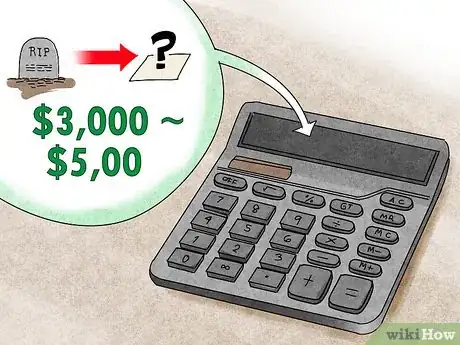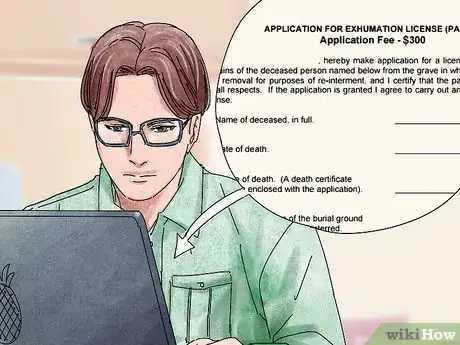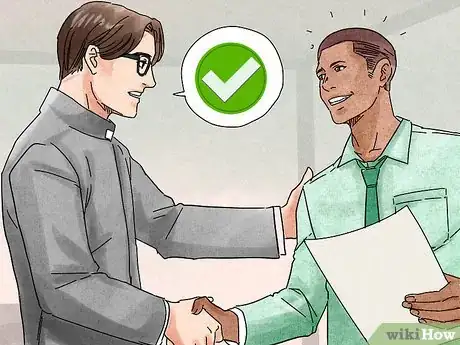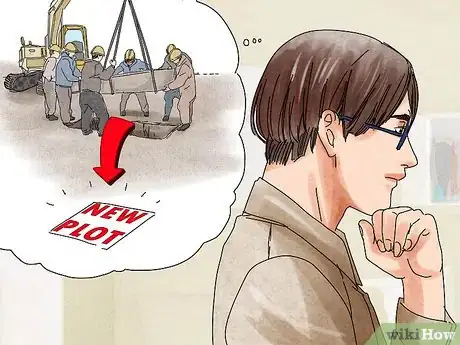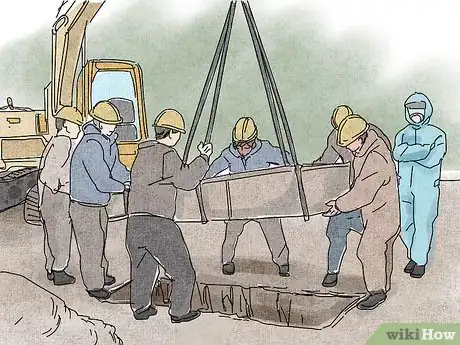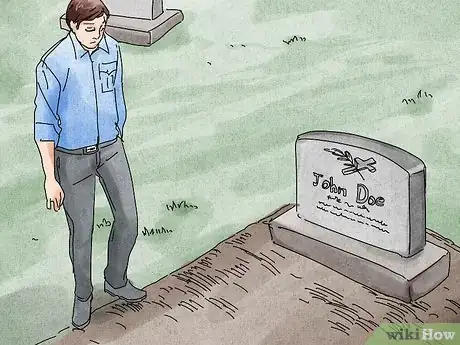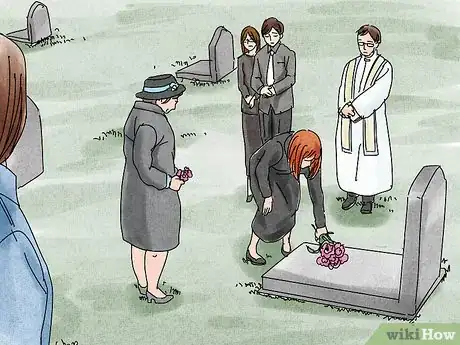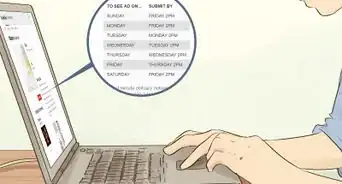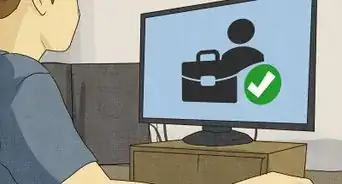This article was co-authored by David I. Jacobson. David I. Jacobson is the founder of Chicago Jewish Funerals, an independent Jewish owned funeral provider that evolved into two funeral homes in the Chicagoland area. With over 30 years of experience serving families, David is a leading expert on Kavod Hamet, the Jewish traditions of honoring and respecting the dead. David is an active funeral director that serves people planning and in need of funerals, lecturing to congregations, community groups, and schools extensively about the values of the Jewish funeral as well as the dying process and the value of one’s legacy.
This article has been viewed 91,357 times.
You may decide to move a gravesite because your deceased relative was buried in a cemetery plot you no longer wish to keep or the deceased was buried out of state. Moving a gravesite may also be done because the cemetery is too crowded to accommodate the rest of the family when they pass or because you have decided to cremate the remains instead of keeping the burial. You should take the necessary steps to prepare for the move and then move the gravesite with care.
Steps
Preparing for the Move
-
1Determine the costs for moving the gravesite. There are numerous costs associated with moving the gravesite. You will need to first pay for the exhumation of the grave and then pay for the re-burial of the casket or coffin. You should make sure you are able to cover the costs of both processes before you commit to them.[1]
- The costs for exhuming the grave may cost $3,000-$5,000 for the exhumation itself. If you need to have a funeral director at the exhumation, that may cost $1,000 or more.
- You will also need to pay for the disposal of the previous casket if you are keeping the biological remains and not the casket.[2]
- You will then need to pay the fees for re-burial of the casket. You will need to pay for transportation of the casket by hearse or a container truck. You may also need to buy a new plot, a new headstone, and possibly a new casket. You may also need to have the funeral director present for the burial at the new plot.[3]
-
2Apply for an exhumation license. You will need to get an exhumation license and/or a disinterment permit to exhume the grave. You should ask the cemetery where the deceased is buried about applying for an exhumation license in that state or area.[4]
- To apply for the license, you will need to be authorized to act in the interests of the deceased, usually given to a next of kin. This authorization may be in the form of signatures of living, close relatives of the deceased. You may also need to get the signatures of the owner of the grave plot and the burial authority.
- The cost of the exhumation license can vary from state to state and country to country. You can apply for the exhumation license online through your government's death and bereavements department or in person.[5]
Advertisement -
3Get the approval of religious officials. You may need a written agreement by a religious official from an affiliated church in the area of the grave or the church of the deceased. Moving a grave on consecrated ground is not taken lightly by religious officials and you should reach out to a religious official to get a formal or informal agreement from them about the move.[6]
- You may want to ask the cemetery where the grave is located if they have a church they are affiliated with in the area. You may be able to contact the church and ask for approval for the move.
-
4Set up transportation for the grave. You should make body transfer plans before you proceed with the move. You may need to hire a hearse through the cemetery for transporting the grave to the new plot, or hire a container truck if a hearse is not appropriate. You should speak to the cemetery and make transportation arrangements so it is clear where the casket is going once it has been exhumed.[7]
- You should also be in contact with the new funeral home and cemetery. You should make sure the new plot is prepared and ready for the casket on the same day as the exhumation. This will make transport and re-burial easier.
Moving the Gravesite
-
1Decide if you will be present for the exhumation. You are not required to be present for the exhumation, as you only need to have the license approved and ready to show the necessary officials. The exhumation can be unpleasant to watch and may end up being a lengthy process. You may decide to skip the exhumation if you do not want to be present for the gruesome moments of the procedure.[8]
- You do not need to be present for the exhumation but you do need to make sure the proper officials are present. Moving a grave is a potential public health hazard, so you should make sure there is an environmental health officer present during the exhumation. You may also want the funeral director to be present during the exhumation to make sure the process goes smoothly.
-
2Confirm the grave has been moved. You should follow up with the funeral director at the cemetery to confirm the grave has been moved to the new plot. You may also contact the funeral director at the new plot to make sure the grave has been exhumed and moved properly.[9]
- You may also visit the new plot to check that the new headstone and site has been set up correctly. The funeral director may need to be present for the burial of the deceased in the new plot so you should arrange this beforehand.
-
3Have a service for the deceased at the new plot. Some people decide to hold a service at the new plot for the deceased. This will allow you and family or friends to go through the burial process at the new site and get any religious blessings for the deceased at the new site, if needed.[10]
- You should factor in the cost of a service at the new plot as part of your budget for moving the gravesite. You may also discuss your service options with the funeral director at the new cemetery so the process goes smoothly at the new gravesite.
Expert Q&A
Did you know you can get expert answers for this article?
Unlock expert answers by supporting wikiHow
-
QuestionIs it illegal to move a grave?
 David I. JacobsonDavid I. Jacobson is the founder of Chicago Jewish Funerals, an independent Jewish owned funeral provider that evolved into two funeral homes in the Chicagoland area. With over 30 years of experience serving families, David is a leading expert on Kavod Hamet, the Jewish traditions of honoring and respecting the dead. David is an active funeral director that serves people planning and in need of funerals, lecturing to congregations, community groups, and schools extensively about the values of the Jewish funeral as well as the dying process and the value of one’s legacy.
David I. JacobsonDavid I. Jacobson is the founder of Chicago Jewish Funerals, an independent Jewish owned funeral provider that evolved into two funeral homes in the Chicagoland area. With over 30 years of experience serving families, David is a leading expert on Kavod Hamet, the Jewish traditions of honoring and respecting the dead. David is an active funeral director that serves people planning and in need of funerals, lecturing to congregations, community groups, and schools extensively about the values of the Jewish funeral as well as the dying process and the value of one’s legacy.
Funeral Home Director
-
QuestionHow do you rebury someone with no money?
 David I. JacobsonDavid I. Jacobson is the founder of Chicago Jewish Funerals, an independent Jewish owned funeral provider that evolved into two funeral homes in the Chicagoland area. With over 30 years of experience serving families, David is a leading expert on Kavod Hamet, the Jewish traditions of honoring and respecting the dead. David is an active funeral director that serves people planning and in need of funerals, lecturing to congregations, community groups, and schools extensively about the values of the Jewish funeral as well as the dying process and the value of one’s legacy.
David I. JacobsonDavid I. Jacobson is the founder of Chicago Jewish Funerals, an independent Jewish owned funeral provider that evolved into two funeral homes in the Chicagoland area. With over 30 years of experience serving families, David is a leading expert on Kavod Hamet, the Jewish traditions of honoring and respecting the dead. David is an active funeral director that serves people planning and in need of funerals, lecturing to congregations, community groups, and schools extensively about the values of the Jewish funeral as well as the dying process and the value of one’s legacy.
Funeral Home Director
-
QuestionHow much does it cost to relocate a grave site?
 David I. JacobsonDavid I. Jacobson is the founder of Chicago Jewish Funerals, an independent Jewish owned funeral provider that evolved into two funeral homes in the Chicagoland area. With over 30 years of experience serving families, David is a leading expert on Kavod Hamet, the Jewish traditions of honoring and respecting the dead. David is an active funeral director that serves people planning and in need of funerals, lecturing to congregations, community groups, and schools extensively about the values of the Jewish funeral as well as the dying process and the value of one’s legacy.
David I. JacobsonDavid I. Jacobson is the founder of Chicago Jewish Funerals, an independent Jewish owned funeral provider that evolved into two funeral homes in the Chicagoland area. With over 30 years of experience serving families, David is a leading expert on Kavod Hamet, the Jewish traditions of honoring and respecting the dead. David is an active funeral director that serves people planning and in need of funerals, lecturing to congregations, community groups, and schools extensively about the values of the Jewish funeral as well as the dying process and the value of one’s legacy.
Funeral Home Director
References
- ↑ http://www.fsnfuneralhomes.com/articles/average-cost-moving-grave/
- ↑ David I. Jacobson. Funeral Home Director. Expert Interview. 14 July 2020.
- ↑ David I. Jacobson. Funeral Home Director. Expert Interview. 14 July 2020.
- ↑ http://www.imortuary.com/blog/changing-cemeteries-after-the-deceased-has-already-been-buried/
- ↑ https://www.gov.uk/apply-for-an-exhumation-licence
- ↑ http://www.imortuary.com/blog/changing-cemeteries-after-the-deceased-has-already-been-buried
- ↑ http://www.imortuary.com/blog/changing-cemeteries-after-the-deceased-has-already-been-buried
- ↑ http://www.imortuary.com/blog/changing-cemeteries-after-the-deceased-has-already-been-buried/
- ↑ http://www.imortuary.com/blog/changing-cemeteries-after-the-deceased-has-already-been-buried/
About This Article
If you need to move a gravesite, you’ll need to prepare for the move beforehand. There are a number of costs involved with moving a gravesite, including the exhumation of the grave, which can cost 3 to 5 thousand dollars. Depending on where you live, you might also have to apply for a state permit for the exhumation. You’ll also need to get an exhumation license or a disinterment order from the probate court. Then, be prepared to pay for the transportation of the casket to the new burial site, buy a new plot and headstone, and pay for the re-burial. To learn how to get approval from religious officials, keep reading!
